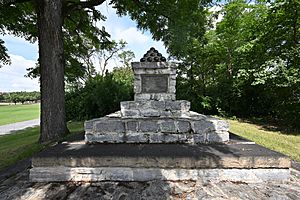Adam Stephen facts for kids
Quick facts for kids
Adam Stephen
|
|
|---|---|
| Member of the Virginia House of Delegates from the Berkeley County, Virginia district |
|
| In office May 1, 1780 – October 16, 1785 Serving with Moses Hunter
Dolphin Drew |
|
| Preceded by | Thomas Hite |
| Succeeded by | Philip Pendleton |
| Personal details | |
| Born | circa 1718 Scotland |
| Died | July 16, 1791 Martinsburg, Virginia |
| Alma mater | King's College, Aberdeen |
| Profession | doctor |
Adam Stephen (born around 1718 – died July 16, 1791) was a doctor and military leader. He was born in Scotland and later moved to America. He helped create the town that is now Martinsburg, West Virginia.
Stephen served as an officer in the Province of Virginia's army. He fought alongside George Washington in the French and Indian War. He also served under Washington again during the American Revolutionary War. He became a high-ranking general in the Continental Army. After an event during the Battle of Germantown, he left the army. However, he remained an important person in western Virginia. He even served in the Virginia government.
Contents
Early Life and Education
Adam Stephen was born in Scotland around 1718. He went to King's College in Aberdeen and earned a degree. He also studied medicine in Edinburgh. Stephen later married and had one child, a daughter named Ann.
Becoming a Doctor and Moving to America
Stephen first worked as a doctor on a hospital ship for the Royal Navy. In the late 1730s or early 1740s, he moved to the British colony of Virginia. He started his own medical practice in Fredericksburg.
Military Service and Frontier Life
Fighting in the French and Indian War
In 1754, Stephen joined the local military forces. He became a high-ranking officer in the Virginia Regiment. This group was led by George Washington. They were based in Winchester.
Stephen and his unit explored areas west of the Appalachian Mountains. They also fought in battles against Native Americans. These included battles at Jumonville Glen and Fort Necessity in 1754. Some people see these as the start of the French and Indian War.
The next year, Stephen, Washington, and the Virginia militia took part in the difficult Braddock Expedition. In 1756, Stephen led Virginia soldiers to help colonists in South Carolina. By 1759, he was in charge of Fort Bedford. He asked for supplies to be sent to Fort Pitt, which is now Pittsburgh.
Dealing with Native American Relations
In 1761, Stephen helped organize the Timberlake Expedition. This trip tried to make peace between the British and the Cherokee. This was after the Anglo-Cherokee War, which was part of the larger French and Indian War.
In 1763, settlers complained about attacks by Delaware and Shawnee tribes. Many people left their homes. Governor Francis Fauquier asked Colonel Stephen to gather 500 men from local militias. Their job was to guard posts and protect settlers.
In 1764, Stephen took over command of the Virginia Regiment from George Washington. He traveled west to help stop Pontiac's Rebellion. This was a major uprising by Native American tribes against British rule.
Serving in the American Revolution
When the American Revolutionary War began, Stephen joined the Continental Army. He served under George Washington once more. He was with the army during the battles in New York and New Jersey in 1776 and early 1777.
As a major general, he led a division of Washington's army. This was during the defense of Philadelphia. In October 1777, during the Battle of Germantown, Stephen's soldiers accidentally fought with troops led by General Anthony Wayne. After this incident, Stephen was removed from the army.
Political Career and Founding Martinsburg
Before the war, Stephen lived in western Virginia. In 1775, voters from Berkeley County chose him as one of their representatives. He attended the Second Virginia Revolutionary Convention in Richmond.
After the war, he returned to Berkeley County. In 1778, Stephen planned out the town of Martinsburg. He named it after his friend, Colonel Thomas Bryan Martin. Stephen became the sheriff of Berkeley County, with Martinsburg as the main town. Other famous generals, Horatio Gates and Charles Lee, later bought land and lived nearby.
In 1780, Berkeley County voters elected Stephen to the Virginia House of Delegates. In 1788, he was chosen to attend the Virginia Ratifying Convention. Here, he spoke and voted to approve the Constitution of the United States. Even though powerful leaders like Patrick Henry and George Mason were against it, Virginia approved the Constitution. This was largely because delegates from western Virginia, including Stephen, supported it.
Legacy and Historic Sites
Adam Stephen passed away in Martinsburg in 1791. He is buried under a monument built in his honor.
The Adam Stephen House in Martinsburg still stands today. Also, The Bower near Shepherdstown was on land he owned. Both of these places are listed on the National Register of Historic Places.


